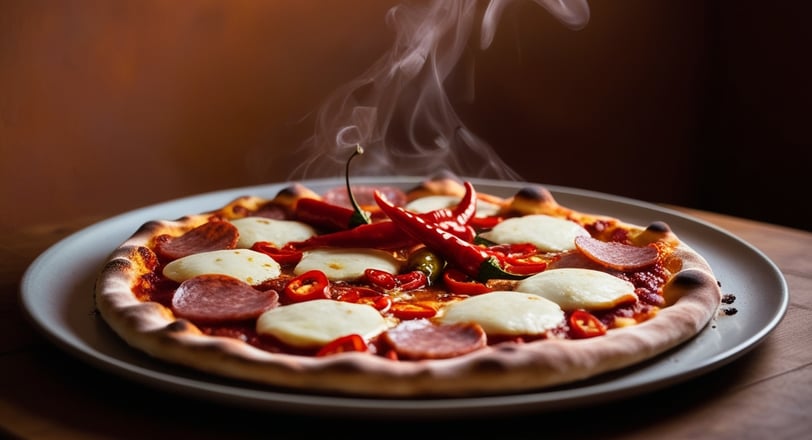How to Make Diavola: The Perfect Spicy Pizza Recipe
FOOD
10/19/20245 min read


Introduction to Diavola Pizza
Diavola pizza, a favorite among food enthusiasts, particularly appeals to those with a penchant for spice. This flavorful dish hails from Italy, where its origins trace back to Southern regions, where bold flavors and spicy dishes are traditionally embraced. The name "Diavola," which translates to "devil" in Italian, aptly reflects the pizza's fiery profile, characterized by the prominent use of spicy salami and chili peppers.
As this pizza gained popularity beyond its regional roots, it has captured the hearts of many around the globe. Its rising fame can be attributed to the increasing demand for exciting flavors in comfort foods, where pizza reigns supreme. The harmonization of its spicy elements creates an unforgettable taste experience, distinguishing Diavola pizza from other traditional varieties. For spice lovers, this dish is not just a meal; it's an adventure in flavor that reflects the spirit of Italian cuisine, known for its fresh ingredients and robust tastes.
At the heart of Diavola pizza are the traditional ingredients that enhance its distinctive character. The combination of spicy salami—a key ingredient that provides heat—and creamy mozzarella cheese creates a delightful contrast in texture and flavor. Chili peppers, typically sliced thin, are generously scattered throughout, elevating the spiciness and contributing to the overall personality of the dish. This quintessential blend of flavors has made Diavola pizza a beloved choice for those seeking a bit of fire in their meals, and its cultural significance continues to thrive as it makes its mark in pizzerias worldwide.
Choosing the Right Ingredients
Creating an authentic Diavola pizza begins with selecting high-quality ingredients that harmonize to produce an exceptional flavor. One of the essential components is the salami, which should ideally be a spicy variety such as Napoli, calabrese, or a similar artisanal product. Look for salami made from premium cuts of meat, free of fillers and additives, to ensure the best taste and texture. Local Italian delis often carry a selection of these authentic options, as well as online gourmet food retailers that specialize in imported products.
Fresh mozzarella is another crucial ingredient, often regarded as the cheese of choice for pizzas. Opt for mozzarella di bufala, known for its creamy texture and rich flavor derived from water buffalo milk. If this is unavailable, a high-quality cow's milk mozzarella can be a suitable alternative. It is important to avoid pre-shredded varieties, as they often contain preservatives that detract from the cheese’s quality. When shopping for mozzarella, check local farmers' markets for artisanal producers who prioritize freshness and traditional methods.
Chili peppers are the defining element of a Diavola pizza, providing the necessary heat that distinguishes this dish. Depending on personal spice tolerance, consider options such as Calabrian chili flakes, jalapeños, or even fresher varieties like Fresno peppers. For those who enjoy an extra kick, some prefer experimenting with the addition of spicy oil or crushed red pepper flakes. When sourcing chili peppers, look at local grocery stores or specialty spice shops for the best range of flavors and heat levels.
Lastly, for individuals with dietary restrictions, such as gluten intolerance or lactose sensitivities, there are alternatives available. Gluten-free pizza crusts can be found in many health food stores, while dairy-free cheese options are becoming increasingly popular. These substitutions allow everyone to savor the delightful experience of Devila pizza without compromising their dietary needs.
Preparation Method: Step-by-Step Guide
To create the perfect Diavola pizza, it is essential to start with a well-made dough. Begin by mixing 500 grams of high-protein flour with 325 milliliters of warm water, 10 grams of salt, and 2 grams of active dry yeast. Combine the ingredients in a large bowl until a rough dough forms. Transfer the dough to a lightly floured surface and knead it for about 10 minutes until it becomes smooth and elastic. This kneading process is crucial as it develops the gluten necessary for a chewy texture.
After kneading, place the dough in a lightly oiled bowl, cover it with a cloth, and let it rise in a warm area for approximately 1 to 2 hours, or until it has doubled in size. This fermentation process enhances the flavor and texture of the crust. Once risen, gently punch down the dough to release excess air, and divide it into two equal portions, shaping each into a ball. Allow these dough balls to rest for 30 minutes to an hour; this will help relax the gluten, making it easier to shape.
Next, preheat your oven to the highest setting, ideally around 250°C (482°F). If you are using a pizza stone, place it in the oven as it heats, allowing it to reach the right temperature for a crispy base. To shape the pizza, take one dough ball and place it on a floured surface. Gently stretch the dough from the center outwards using your fingers, rotating it as you work to form a circle about 10-12 inches in diameter.
Once shaped, transfer the dough onto a pizza peel or an inverted baking tray dusted with flour. Spread a thin layer of tomato sauce over the base, ensuring to leave about one-inch borders. For the classic Diavola flavor, add toppings such as spicy salami, mozzarella cheese, and a sprinkling of chili flakes. Finally, bake the pizza in the oven for about 10-12 minutes, or until the crust is golden brown and the cheese is bubbling. Rotate the pizza halfway through cooking for an even bake, and serve hot to enjoy the full flavor of your homemade Diavola pizza.
Serving Suggestions and Pairings
Diavola pizza, known for its robust spicy flavors, can be an exquisite centerpiece for a meal, but thoughtful serving suggestions and pairings can truly enhance the dining experience. To complement the heat of the pizza, it is advisable to serve it alongside cooling side dishes. A classic arugula salad dressed with olive oil and lemon works wonderfully to balance the spiciness, providing a fresh contrast that helps cleanse the palate. Another option is a creamy coleslaw, which adds a delightful crunch and a hint of sweetness to counteract the heat.
Dips also play a significant role in enriching the overall experience of enjoying Diavola pizza. A tangy yogurt dip infused with herbs could serve as an excellent accompaniment, offering a cool and creamy counterpoint to the pizza’s bold flavor. Alternatively, a spicy marinara sauce for dipping can elevate the experience for those who crave even more zest. Additionally, you may incorporate a selection of pickled vegetables to add a tangy crunch that complements both the flavor and texture of the pizza.
When it comes to beverage pairings, a well-chilled lager or a fruity rosé are great options, as they refresh the palate between bites. For a non-alcoholic choice, a sparkling water infused with citrus can also provide a zesty cleanse. If you wish to experiment with the heat level of your Diavola pizza, consider adding or reducing the amount of chili flakes according to personal preference. This way, everyone can enjoy this spicy delight, whether they are spice enthusiasts or prefer milder flavors. Encouraging creativity in toppings or even trying variations such as a Diavola-inspired calzone could further personalize the dish and excite the taste buds for a memorable meal.
Wellness
Explore beauty tips and holistic health insights
contact us
Balance
sapwans2005@gmail.com
© 2024. All rights reserved.
